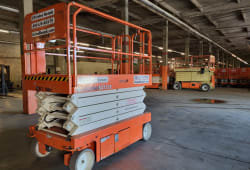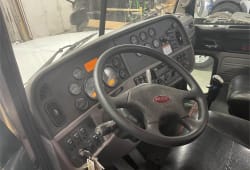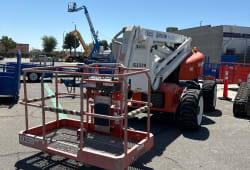Packaging & Presentation: Enhancing Buyer Perceptions of Heavy Equipment
13 Min read
)
August 11, 2023
In the world of heavy equipment sales, packaging,and presentation play a crucial role in capturing the attention of potential buyers. Just like any other product, heavy equipment needs to be packaged and presented in a way that enhances its desirability and perceived value. In this article, we will explore the importance of packaging and presentation in the heavy equipment industry, discuss the psychology behind buyer perceptions, analyze key elements of effective packaging, and share strategies for enhancing equipment presentation. We will also delve into real-life case studies of successful packaging and presentation in the industry and explore future trends in this field.
Understanding the Importance of Packaging and Presentation in Heavy Equipment Sales
When it comes to heavy equipment, packaging, and presentation are often overlooked aspects of the sales process. However, these elements can greatly influence buyer perceptions and ultimately, purchasing decisions. Buyers are not just looking for functional equipment; they also want equipment that looks appealing and professional. Packaging and presentation serve as the first impression for potential buyers, and it is through these elements that they form initial judgments about the quality and value of the equipment.
The Psychology Behind Buyer Perceptions
Buyers are influenced by both conscious and subconscious factors when evaluating heavy equipment. Psychologically, they are more likely to view well-packaged and well-presented equipment as superior and trustworthy. These visual cues create a positive perception of the equipment's quality, reliability, and value.
Moreover, research has shown that buyers tend to associate a neat and visually appealing presentation with a higher level of professionalism and attention to detail. This perception can instill confidence in the buyer, making them more inclined to consider the equipment as a worthy investment.
The Role of Packaging in Product Perception
Packaging plays a crucial role in shaping buyer perceptions. The choice of materials, design, and size all contribute to how buyers perceive the equipment. For instance, durable and protective packaging materials not only safeguard the equipment during transportation but also communicate that the manufacturer values quality and takes pride in their products.
In addition, packaging can also be used as a marketing tool. Manufacturers can use the packaging to highlight key features and benefits of the equipment, making it more enticing to potential buyers. By strategically designing the packaging to showcase the equipment's strengths, manufacturers can create a positive first impression that sets their product apart from the competition.
How Presentation Influences Buying Decisions
Equipment presentation is equally important as packaging. When presenting heavy equipment, manufacturers should take into account factors such as cleanliness, maintenance, and organization. AClean and well-maintained equipment is more likely to leave a positive impression on potential buyers. Organizing the equipment and showcasing its features in a logical and easy-to-understand manner can also help buyers make informed decisions.
Furthermore, the presentation should aim to create an immersive experience for the buyer. This can be achieved by providing detailed product information, such as specifications, performance data, and customer testimonials. By presenting the equipment in a comprehensive and informative manner, manufacturers can build trust and credibility with potential buyers, increasing the likelihood of a successful sale.
It is also worth noting that the presentation should be tailored to the target audience. Different buyers may have varying priorities and preferences when it comes to heavy equipment. Manufacturers should consider these factors and customize their presentation accordingly, highlighting the aspects that are most relevant and appealing to the specific buyer.
Key Elements of Effective Heavy Equipment Packaging
Effective heavy equipment packaging relies on a combination of factors. Here are some key elements to consider:
Material Selection for Durability and Protection
Choosing durable and protective materials for packaging ensures the equipment reaches its destination in optimal condition. Materials such as corrugated cardboard, foam inserts, and shrink-wrapping can effectively protect heavy equipment during transportation.
Corrugated cardboard is an excellent choice for heavy equipment packaging due to its strength and rigidity. It provides a sturdy structure that can withstand the weight and pressure of the equipment during transit. Additionally, foam inserts can be customized to fit the contours of the equipment, providing extra cushioning and preventing any potential damage caused by impact.
Shrink-wrapping, on the other hand, offers an additional layer of protection by tightly sealing the equipment and preventing dust, dirt, and moisture from entering the packaging. This is particularly important when shipping heavy equipment over long distances or in harsh weather conditions.
Design Considerations for Visibility and Branding
The design of the packaging should not only focus on protection but also visibility and branding. Including the company logo, colors, and product images on the packaging allows for instant recognition and reinforces brand identity.
When it comes to heavy equipment packaging, visibility is crucial. By incorporating high-contrast colors and bold graphics, the packaging can stand out in a crowded warehouse or on a busy construction site. This not only makes it easier to locate the equipment but also enhances brand visibility and recognition.
Furthermore, the packaging design should align with the overall brand image and values. For example, if a company prides itself on innovation and cutting-edge technology, the packaging design should reflect this through modern and sleek aesthetics. On the other hand, if a company focuses on reliability and durability, the packaging design can convey a sense of strength and ruggedness.
Packaging Size and Its Impact on Perceived Value
The size of the packaging can also influence buyer perceptions of the equipment. Larger packaging may convey a sense of substantiality and quality, while compact packaging can communicate efficiency and ease of use. It is essential to strike the right balance and align the packaging size with the equipment's features and value.
When considering the packaging size, it is important to take into account the dimensions and weight of the equipment. Oversized packaging may lead to unnecessary shipping costs and storage space requirements, while undersized packaging may compromise the equipment's safety during transit.
Moreover, the packaging size should reflect the equipment's value and functionality. For high-end heavy equipment, larger packaging can create a sense of prestige and exclusivity. On the other hand, compact packaging may be more suitable for equipment that emphasizes portability and ease of transport.
By carefully considering the material selection, design, and packaging size, heavy equipment manufacturers can ensure their products are not only protected during transportation but also leave a lasting impression on their customers. Effective packaging enhances brand perception, reinforces product value, and ultimately contributes to customer satisfaction.
Strategies for Enhancing Presentation of Heavy Equipment
Now that we have explored the key elements of effective packaging, let's delve into strategies for enhancing the presentation of heavy equipment:
When it comes to showcasing heavy equipment, utilizing visual aids for effective demonstrations can make a significant impact on buyer engagement. Visual aids such as videos, images, and interactive displays have the power to captivate potential buyers and provide them with a clearer understanding of how the equipment works and its capabilities. These aids not only make the sales process more efficient but also help potential buyers visualize how the equipment can meet their specific needs.
In addition to visual aids, detailed product descriptions play a crucial role in enhancing equipment presentation. Buyers often seek detailed technical specifications, features, and benefits before making a purchase decision. By providing clear and comprehensive product descriptions, sellers can satisfy these requirements and provide potential buyers with the necessary information to make an informed choice. Detailed descriptions can highlight the unique selling points of the equipment, making it stand out from competitors and increasing its appeal.
However, it's not just about the visual and informational aspects of presentation; cleanliness and maintenance also play a vital role. Maintaining clean and well-maintained equipment is crucial in enhancing its overall presentation. Regular cleaning not only improves the visual appeal of the equipment but also signals its reliability and longevity. Buyers are more likely to trust and invest in equipment that is well taken care of. Additionally, regular maintenance ensures that the equipment operates at its optimal level, showcasing its efficiency and performance.
Furthermore, sellers can go the extra mile by providing additional information about the equipment's history and usage. This can include details about previous owners, maintenance records, and any notable achievements or milestones the equipment has accomplished. Sharing this information adds a layer of transparency and builds trust with potential buyers, making them more confident in their decision to invest in the equipment.
Another strategy for enhancing the presentation of heavy equipment is to offer potential buyers the opportunity to test it out firsthand. Organizing equipment demonstrations or providing trial periods allows buyers to experience the equipment's performance and functionality themselves. This hands-on experience can be a powerful selling tool, as it allows buyers to see the equipment in action and assess its suitability for their specific needs.
In conclusion, enhancing the presentation of heavy equipment involves utilizing visual aids, providing detailed product descriptions, maintaining cleanliness and regular maintenance, sharing additional information about the equipment's history and usage, and offering opportunities for potential buyers to test it out firsthand. By implementing these strategies, sellers can effectively showcase their heavy equipment and increase their chances of making successful sales.
Case Studies: Successful Packaging and Presentation in Heavy Equipment Industry
Real-life case studies provide valuable insights into effective packaging and presentation strategies. Let's explore some notable examples:
Caterpillar Inc.: A Study in Brand Consistency
Caterpillar Inc. is renowned for its consistent and recognizable packaging across its wide range of heavy equipment. The iconic yellow packaging with the Caterpillar logo has become synonymous with reliability and durability in the industry.
One of the key reasons behind Caterpillar's success in packaging and presentation is its unwavering commitment to brand consistency. By using the same yellow color and logo on all their packaging, they have created a strong visual identity that customers instantly recognize. This consistency not only helps in building trust but also reinforces the brand's image of reliability and durability.
In addition to the color and logo, Caterpillar also pays attention to the quality of their packaging materials. They use sturdy and durable materials that can withstand the rigors of transportation and protect the equipment from any potential damage. This attention to detail further enhances the perception of quality and reliability associated with the brand.
John Deere: Leveraging Green for Instant Recognition
John Deere is another industry leader that utilizes packaging to its advantage. By incorporating their signature green color in their packaging, they have created instant recognition and association with their brand among potential buyers.
The use of green packaging by John Deere is not a random choice but a strategic decision. Green has long been associated with nature, growth, and freshness. By incorporating this color into their packaging, John Deere taps into these positive associations and creates a subconscious connection between their brand and the outdoors. This connection is particularly relevant in the heavy equipment industry where the equipment is often used in agricultural and landscaping settings.
Moreover, John Deere's packaging goes beyond just color. They also focus on the design and layout of their packaging to make it visually appealing and informative. The packaging showcases the key features and benefits of the equipment, making it easier for potential buyers to understand the value proposition. This combination of visual recognition and informative packaging helps John Deere stand out in a competitive market.
Komatsu Ltd.: Balancing Functionality and Aesthetics in Packaging
Komatsu Ltd. is known for striking the right balance between functionality and aesthetics in its packaging. Their packaging not only protects the equipment but also showcases its features and capabilities, leaving a lasting impression on buyers.
When it comes to packaging heavy equipment, functionality is of utmost importance. Komatsu understands this and ensures that their packaging is designed to provide maximum protection during transportation and storage. They use materials that are strong, impact-resistant, and weatherproof, ensuring that the equipment reaches its destination in optimal condition.
However, Komatsu doesn't stop at functionality alone. They also pay attention to the aesthetics of their packaging. By incorporating visually appealing elements such as sleek designs, high-quality graphics, and attention-grabbing colors, Komatsu's packaging stands out from the competition. This attention to aesthetics not only enhances the overall presentation but also creates a positive perception of the brand.
Furthermore, Komatsu's packaging is designed to showcase the equipment's features and capabilities. They include clear and concise information about the equipment's specifications, performance, and unique selling points. This not only helps potential buyers make informed decisions but also leaves a lasting impression of professionalism and reliability.
Future Trends in Heavy Equipment Packaging and Presentation
As technology advances and customer preferences change, the future of heavy equipment packaging and presentation is likely to witness several exciting trends:
The Rise of Eco-Friendly Packaging Solutions
As sustainability becomes a top priority for many industries, heavy equipment manufacturers are likely to adopt eco-friendly packaging solutions. Using renewable materials and creating recyclable packaging can not only reduce the environmental impact but also resonate with environmentally conscious buyers.
Imagine a future where heavy equipment is packaged in biodegradable materials made from plant-based fibers. These innovative packaging solutions not only protect the equipment during transportation but also decompose naturally, minimizing waste and pollution. Additionally, manufacturers could explore the use of sustainable inks and printing techniques to further enhance the eco-friendly aspect of their packaging.
Virtual Reality and Augmented Reality in Equipment Presentation
Virtual reality (VR) and augmented reality (AR) technologies have the potential to revolutionize equipment presentation. These immersive technologies can allow potential buyers to experience the equipment in virtual environments, empowering them to make informed decisions without physical interaction.
Imagine being able to put on a VR headset and walk around a virtual construction site, operating heavy equipment and experiencing its capabilities firsthand. With AR, potential buyers could visualize how the equipment would fit into their existing operations, overlaying virtual models onto their real-world surroundings. This level of interaction and visualization would not only enhance the buying experience but also save time and resources by eliminating the need for physical demonstrations.
Personalization and Customization: The Next Big Thing?
Personalization and customization are gaining traction across various industries. Heavy equipment manufacturers may explore the possibilities of offering personalized packaging and presentation options to buyers. This could range from customized branding to tailored product demonstrations, providing a unique and memorable experience for potential buyers.
Imagine receiving a heavy equipment package that is personalized with your company's logo and colors, creating a sense of exclusivity and pride. Manufacturers could also offer customized product demonstrations, allowing potential buyers to see the equipment in action, specifically tailored to their industry needs. This level of personalization not only strengthens the buyer-seller relationship but also showcases the manufacturer's commitment to meeting individual customer requirements.
Enhancing buyer perceptions of heavy equipment through packaging and presentation is not just about aesthetics; it is about building trust, communicating quality, and creating a memorable experience for potential buyers. By understanding the importance of these elements, manufacturers can effectively differentiate their products in a competitive market and ultimately drive sales.
Furthermore, heavy equipment manufacturers could also leverage smart packaging technologies to provide real-time updates and information to buyers. Imagine a package that contains sensors, enabling it to track the equipment's location, condition, and maintenance needs. This level of connectivity and transparency would not only instill confidence in the buyer but also streamline after-sales support and service.
In conclusion, the future of heavy equipment packaging and presentation holds immense potential for innovation and improvement. From eco-friendly solutions to immersive technologies and personalized experiences, manufacturers have the opportunity to reshape the industry's standards and exceed customer expectations. By embracing these future trends, heavy equipment manufacturers can stay ahead of the curve and pave the way for a more sustainable, engaging, and customer-centric future.

Caleb Woods is an experienced content specialist and an editor at Boom & Bucket, blending his journalism background with expertise in the heavy equipment industry. He delivers engaging, informative content to help professionals stay informed and make smarter decisions in the machinery market.











